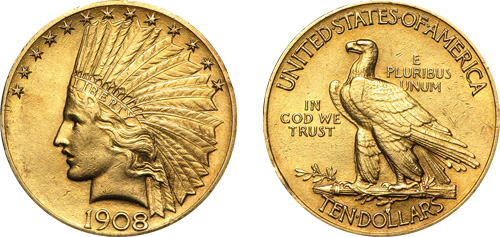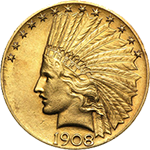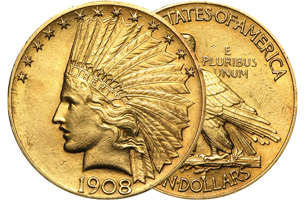Normally, coins in a series look very similar, allowing only for slight deviations from the original design. Yet, when compared to the $2.50 or $5 Indian Head, the Indian Head $10 gold coin looks dramatically different. While the obverse side of the former depicts the profile of a male Native American, the latter features none other than Lady Liberty in a headdress. Also, rather than having the recessed images of the quarter and half Indian Head gold eagle, the $10 gold eagle’s design is raised in a fairly low relief. The coin was minted from 1907 until 1933.
In 1904, President Theodore Roosevelt tasked famous American sculptor Augustus Saint-Gaudens with creating an innovative Inaugural medal, as he was discontent with the plain medal designed by U.S. Mint engravers Charles E. Barber and George T. Morgan. Apparently, Saint-Gaudens sketched the basic design on a napkin while riding on the train. His assistant, Adolph A. Weinman, who was known for designing the Walking Liberty Half Dollar and Mercury Dime, completed the design. The Saint Gaudens/Weinman Inaugural medal received so much acclaim that Roosevelt asked Saint-Gaudens and Barber to fashion a similarly creative design for the country’s coinage. Eventually, the President chose a design that featured the bust of Liberty on the obverse and a standing eagle on the reverse.

Thus, the obverse of the new eagle depicts Liberty facing left, wearing an impressive (albeit historically inaccurate) Native American headdress. “LIBERTY” is inscribed on the headdress while 13 stars circle the top. The mint date is found on the bottom. The reverse of the coin features an eagle standing upon a bundle of arrows that are circled by an olive branch. The face value of “TEN DOLLARS” is inscribed on the bottom. The legend “UNITED STATES OF AMERICA” is located across the top while the nation’s motto “E PLURIBUS UNUM” is stamped to the right of the eagle’s shoulder. During the first year of the coin’s production, the half eagle did not feature the motto “IN GOD WE TRUST” because the President deemed it blasphemous. However, Congress insisted on the inclusion of the motto, and it was placed left of the eagle (“With Motto” variety) in 1908. Coins produced form 1907-1911 feature 46 stars on the edge, whereas coins minted from 1912-1933 display 48 stars (after the incorporation of New Mexico and Arizona).
The U.S. Mint struck the Indian Head $10 from 1907 until 1933. During some years, they were struck at all three branches: Philadelphia, Denver, and San Francisco. At other times, they were only struck at one or two branches. As usual, coins struck in Philadelphia bear no mintmark. The D for Denver or S for San Francisco mark can always be found on the reverse. Typically, it is found left of the arrow bunch. In the 1908-D “No Motto” variety, the mintmark can be found near the leaves by the feet of the eagle. Other varieties of the Indian Head eagle – all from 1907 – include the “Wire Edge” (without raised rim), the “Rolled Edge” (with sharply raised rim), and the “No Periods” (without triangular periods in legend and motto) coin.
Each Indian Head $10 coin consists of 90% gold and 10% copper.
Proof issues of this series come in two main types with various colorations. Matte or sandblast finish eagles have a subdued, microscopically grainy luster on needle-sharp strikes. Matte proofs include the 1907 “Rolled Edge,” 1908 “With Motto,” 1909, and 1911 through 1915 issues. On the other hand, satin or Roman finish proofs features a smooth, glowing surface. Satin proofs encompass the “Plain Edge” 1907, at least one of the 1907 “No Periods” and 1908 “With Motto” issues, as well as 1909 and 1910 coins.
The coin was struck every year from 1907 to 1916, but then minting became sporadic. After World War I, Indian Head gold eagles were only struck in 1920 (at San Francisco), 1926 (at Philadelphia), 1930 (at San Francisco),1932 and 1933 (both at Philadelphia). In 1933, over 300,000 coins were minted in Philadelphia. Executive Order 6260 from President Franklin D. Roosevelt halted circulation entirely in 1933, and most coins from this year were melted down. NGC reports that all dates and mintmarks in gem condition are considered scarce, but the 1920-S, 1930-S, and 1933 varieties are the rarest.
The $10 Indian Head is an iconic gold coin from the early 20th Century. Notable historical figures like Theodore Roosevelt, Augustus Saint-Gaudens, and Charles Barber were all involved in its creation. Hence, Indian Head gold eagles do not only have a sizeable precious metal value, but also tremendous historical worth.


